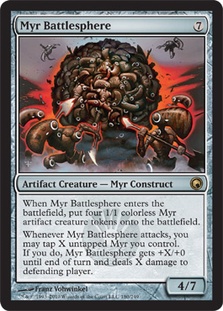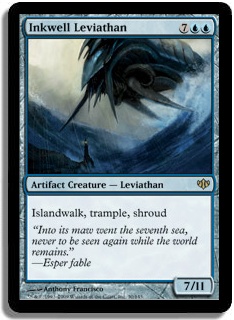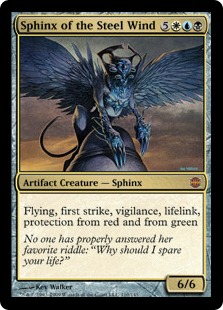Tinker is one of the most absurdly powerful cards ever printed. While Black Lotus is considered the best accelerant in the game for generating three
extra mana, Tinker frequently accelerates out cards, saving the caster four to nine mana. While Demonic Tutor is considered the best search
effect in the game, Tinker can tutor from a wide variety of lethal combo pieces, powerful threats, or disruptive defensive cards – and then put
them into play for free. While Tarmogoyf is considered one of the most cost-effective creatures in the game, Tinker finds a 5/6 for two mana laughable.
For one more mana, Tinker can find a creature that’s indestructible and deals out eleven poison counters with each hit. That’s essentially a creature
with infinite power and infinite toughness; how’s that for cost effective?
After the mass restriction of cards from the Urza’s Saga block, only a few Vintage combo decks still hung onto Tinker. These weren’t the well-tuned
Storm lists you’re familiar with now, however. Tendrils of Agony hadn’t even been printed yet, and players were forced to run all kinds of awkward,
clunky kill cards. Some lists needed Tolarian Academy, Candelabra of Tawnos, Capsize, and nine artifacts to generate infinite mana before
killing with a Stroke of Genius. These decks basically grasped at any card draw they could find, and Tinker for Memory Jar was better than the
Windfalls and Wheels of Fortune they were stuck running anyway.
After the original Mirrodin block, Tinker in Vintage began to spread its wings. The first decks to successfully add Tinker were already artifact-based.
Five-colored Mishra’s Workshop-based decks and the Goblin Welder-centric Control Slaver deck were a natural fit. These decks were already running a
variety of expensive artifacts, so Tinker-as-toolbox made perfect sense. At this point, no one was using Tinker to find anything they wouldn’t have run
without it.
During this period, a friend of mine was having a housewarming party and invited twenty or so Vintage players over for a casual tournament. We all
chipped in five dollars for food and five dollars to a prize pool, and everyone drank and had an all-around good time. Dave Lawrence (who posts as
Eastman on www.themanadrain.com) was there, among pilots of Psychatog, Control Slaver, Dragon Combo, and Workshop decks. At the time, Dave was playing
Keeper, a cerebral, multicolored, extremely late-game control deck. Dave was planning on drinking and wasn’t interested in thinking out the nuances of
a thirty-turn Magic game. As a joke, he opted out of the traditional, slow, control-ish kill cards for Keeper (at the time I believe players were
running Exalted Angel) and decided to just run a Tinker and a Darksteel Colossus.
Now, it’s possible other players in other parts of the world figured out “cheap, giant creature” on their own. At the time, however, we had
assumed Tinker wasn’t good enough to run without supporting cards like Goblin Welder. By the end of that party, we knew better. Within a few months,
Tinkers started cropping up in more and more decks. In less than a year, Gifts Ungiven was printed, and it was hard to imagine a Vintage without
Tinker.
Today, most blue decks run Tinker as a primary or powerful secondary win condition. Tinker provides a large, must-answer threat for a tiny investment
and can often only be answered by spells that are otherwise useless against the deck running it. Tinker is used in Tezzeret decks as a tutor that
happens to double as a huge creature; it’s used in storm combo decks as a draw spell that happens to double as a huge creature. It’s used in Oath of
Druids decks to ignore Oath-specific hate cards without relying on Forbidden Orchard. To play Vintage today, you either need to play or be prepared to
play against Tinker.
But what do you find with it?
Strictly Better
I talked about this broadly in my Mirrodin Besieged review, but I’d like to get a
little more in depth. Choosing a specific card to run (for instance, a large, expensive artifact creature to find with Tinker) uses mostly the same
reasoning as examining cards from a new set. Deciding between two cards is something that comes up in Magic basically all the time. The same thinking
that goes into building a deck is used in sideboarding, drafting, and choosing which cards to protect or destroy during a game.
“Strictly better” is a phrase, which like many game theory terms, is criminally overused in Magic discussion. In Mark Rosewater
article “This Land is My Land,” he says the following:
I guess I should start by explaining what I mean by “strictly better.” This is a phrase R&D tosses around a lot. “Strictly
better” means that one card is in all occurrences (within reason) better than another. An example of a “strictly better” would be
Lightning Bolt versus Shock.
The devil, as always, is in the details, and of course the devil here is the phrase “within reason.” For clarity, when you’re chatting up
Magic with your friends, it’s probably best just to use Rosewater’s definition. When you’re making a deckbuilding decision, though, I’d like you to
consider something else.
In game theory, the “strictly better” has a specific meaning. For something to be strictly better, it must lead to a better outcome no
matter what the other player does. Given this, in Magic, no card is strictly better than another. Because cards like Mindslaver and Meddling Mage
exist, basically every card has some situation in which it’s better than another. Even Ashcoat Bear could lose you a game that Grizzly Bears would’ve
won.
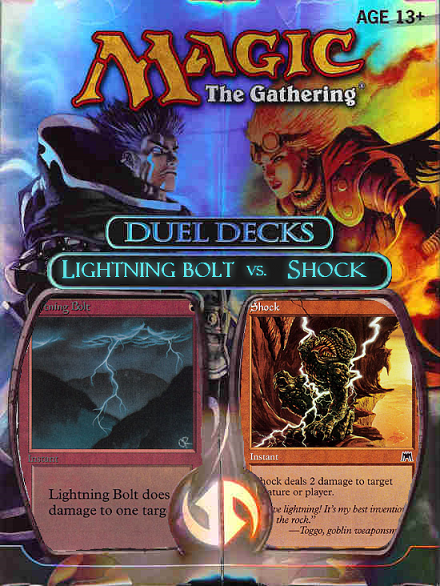 It would be pretty silly for Mark Rosewater and the gang over at WotC to factor in Mindslaver when balancing a new burn spell. It
It would be pretty silly for Mark Rosewater and the gang over at WotC to factor in Mindslaver when balancing a new burn spell. It
would be even sillier for you to start running Grizzly Bears in your decks for fear of Meddling Mage naming Tarmogoyf. It’s important to get this
concept though. When someone says Lightning Bolt is better than Shock, that doesn’t mean that one is always amazing and the other is always terrible.
Like so many expressions in Magic, good, bad, and better are just shortcuts. What they’re really saying is “the situations in which Lightning
Bolt is better than Shock outnumber the situations in which Shock is better than Lightning Bolt”
Humor me here. Let’s spell it all out.
Lightning Bolt versus Shock: When does it not really matter?
When either spell is good enough, e.g. they’re at two life.
When neither spell is good enough, e.g. they’re at four or higher life, and they’re going to win before you find any other damage sources.
It can be tough to nail down exactly what caused you to win or lose a game, but it’s valuable to try. Even in the extremely unlikely event that your
opponent has a Misdirection for your Lightning Bolt and you have a creature out that Lightning Bolt kills but Shock does not, a lot of the
time it won’t really matter.
Many games you’ll just win anyway, despite Bolting your own creature, and many games you’ll just lose anyway, despite the fact that your creature was
Shock-proof. If you’re in a situation where either card would have the same effect on the match, you don’t factor that into your decision.
Note that I said “effect on the match” instead of “effect on the board, life total, or game state.” You don’t get extra points
for being at twenty life when you win or for killing all of your opponent’s creatures before you lose. Make sure you’re not overvaluing effects that
look like they’re helping you out if they’re not actually giving you more wins.
When is Shock better than Lightning Bolt?
When your opponent has a redirection effect and is applying pressure on your life total such that the one extra damage is relevant.
When your opponent has a redirection effect, and you have three-toughness creatures in play (two- or four-toughness creatures don’t factor in;
getting a Lightning Bolt redirected to one of those would have the same effect).
When your opponent casts a Meddling Mage/Cabal Therapy/etc. naming Lightning Bolt.
When is Lightning Bolt better than Shock
When you’re applying pressure to your opponent’s life total such that one extra damage is relevant.
When your opponent has a three-toughness creature.
When your opponent casts a Meddling Mage/Cabal Therapy/etc. naming Shock.
To be fair, this will happen even less than your opponent naming Lightning Bolt. Don’t forget that if they’ve already seen a Shock (because say,
you didn’t read this article, and you’re inexplicably running four of them), the chance goes way up.
Notice how specific the pro-Shock examples are and how general the pro-Lightning Bolt examples are. You also have a lot of control over how often these
things happen. In a deck like Goblins, you have extremely few, if any, creatures with two toughness. In most decks that run burn spells, you already
know you’re going to be applying pressure to your opponent’s life total – so you can assume that the extra damage is relevant from turn 1.
Thank You, Captain Obvious.
Of course, you would have to be pretty stupid to vote Shock over Bolt. There’s a pretty good chance you didn’t need me to spell that out for you. I’m
sure if I had just asked “well which card is better?” you would have come up with the same answer. There are dozens of obvious decisions to
make every time you build a deck. You really don’t need to spell things out to figure out the right card.
Do it anyway.
You need to be ruthless with this. The very idea that there are good cards and bad cards is insidious. For players who are experienced enough to be
past the “obvious mistakes” stage, this is one of the most dangerous mindsets to have. A new player is constantly questioning everything,
but after a little success, it’s really easy to get stuck on your ideas.
If a card is either good or bad, it’s easy to assume that your cards are good. Why would you play them at all if they weren’t good? When a friend,
writer, or irate opponent slanders your choices by calling them terrible – that just doesn’t compute.
Your last-round opponent opened with Black Lotus into triple Jackal Pup, and that Brass Man just crushed him. If Brass Man was a bad card, you would’ve
lost because bad cards lose games. Since Brass Man won the game, it’s not a bad card. Since isn’t a bad card, it has to be a good card.
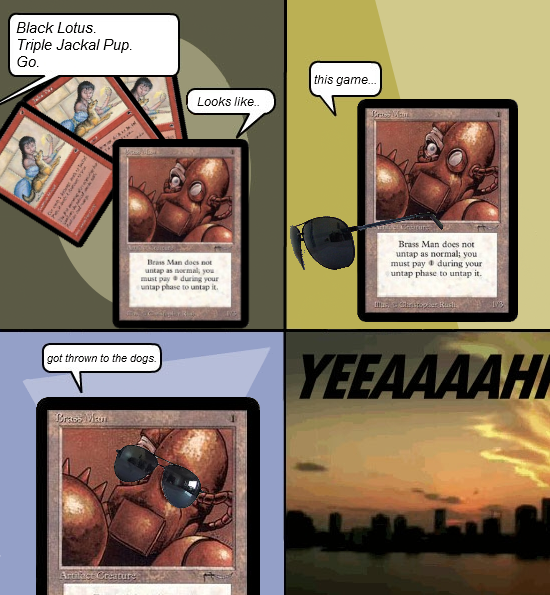
But it’s not good. Though it’s not inherently bad. There are just a set of circumstances where it’s better and a set of circumstances where it’s worse.
Finding the Tinker Target
I’m sure you’ve figured out where I’m going with this.
Right now, commonly played Tinker targets (or “robots”) are Blightsteel Colossus, Inkwell Leviathan, Myr Battlesphere, and Sphinx of the
Steel Wind. What’s a Vintage player to do?
Tinker Target: When does it not really matter?
Remember that, in most games, it doesn’t really matter which card you pick. Many games you’ll just never cast the Tinker at all, or you’ll win
handily with something else. Sometimes, your opponent will stumble early and be unable to answer any Tinker creature quickly enough. Sometimes
you’ll play the Tinker and find something else, like a Black Lotus or Time Vault. Sometimes they’ll Force of Will the Tinker, or answer it with a
Hurkyl’s Recall, or kill you before Tinker matters. All of those games you can ignore for the purpose of this decision.
If you were trying to decide “Do I even want Tinker in the first place?” those games would suddenly become very important. For now, let’s
assume we’re running Tinker and figure out the situations where your robot makes a difference.
My opponent is going to win in four or fewer turns:
You don’t get extra points for winning faster, but you do give your opponent less time to stop you. Each new turn gives an opponent the opportunity
to do any number of things, up to and including just winning. If you’re three turns away from losing, which artifact you find is extremely
important. Blightsteel Colossus wins the fastest, giving them only one turn to beat you. Myr Battlesphere gives them two, Inkwell Leviathan three,
and Sphinx of the Steel Wind four. It’s worth noting that in Vintage, it’s extremely common for a player to deal at least two damage to themselves,
if not more – so Sphinx often takes only three turns, and sometimes an Inkwell or Battlesphere are lethal as quickly as a Blightteel.
TPS, Gush, and Ichorid represent the fastest decks in the format right now. The more common those decks are, the more often you’ll be in this
situation. Furthermore, the more common those decks are, the worse Tinker is in general.
In the past, some players have compensated for fast metagames with cards that do something right now. Mindslaver and Jester’s Cap can be
devastating against fast decks but worthless against others.
My opponent has chump blockers.
All currently popular Tinker targets have some form of evasion to help them avoid blockers. Against blue decks, Inkwell is the best, as it’s
completely unblockable. However, against non-blue decks, Inkwell is the worst. Two Tarmogoyfs, a Wurmcoil Engine, or a Karn, Silver Golem can kill
or hold off Inkwell indefinitely. Battlesphere also has some trouble against blockers but always gets at least four damage through.
With Metalworker–Steel Hellkite decks all the rage right now, blocking can be a pretty significant problem in a Workshop-heavy field. You really don’t
want to have a Tinker target that can’t get through. In particular, if you expect Wurmcoil Engines, an Inkwell or Battlesphere is almost worthless.
My blue-based control opponent is trying to answer my robot.
If the other player can’t win, they’re going to try and dig for an answer. A blue-based control deck is most likely to have answers in the form of
bounce spells – Hurkyl’s Recall, Jace, the Mind Sculptor, or even Steel Sabotage. Inkwell is entirely immune to everything but Hurkyl’s
Recall. Battlesphere can be bounced by a targeted spell or ability but will leave behind four Myr tokens, which are enough to kill off a Jace or
fend of Confidants.
Don’t forget, however, that speed factors in here as well. Consider a typical blue deck with one Hurkyl’s Recall, two Jace, the Mind Sculptors, and
one Echoing Truth maindeck. The deck is likely to have tutors as well, one Demonic Tutor, one Mystical Tutor, one Vampiric Tutor, one Merchant
Scroll. Assume it’s fairly early in the game, and your opponent has 50 cards left in their deck. If you were to Tinker out an Inkwell Leviathan,
your opponent would have three turns to find one of five answers (Hurkyl’s Recall or any tutor) – that’s about a 30% chance. If you were to
Tinker out a Blightsteel Colossus, they have eight answers but only one turn to find them – a 16% chance. That’s not even factoring in that
Mystical and Vampiric Tutor don’t really count as outs against Colossus unless they’re already in hand. Good offense is a great defense here.
Sphinx comes in dead last, as it gets hit by any removal a blue deck would run and gives them as much time as possible to find it.
Most of the time, blue-based control doesn’t fight Tinker by answering the creature. If your opponent has an aggressive hand, they’ll try to race it,
and if they have a defensive hand, they won’t let it resolve. If their hand doesn’t have the ability to race or stop it, they likely weren’t in very
good shape that game anyway. Usually if removal is involved, it’s when the Tinker is thrown out early as a gambit. Most of the time, Tinker is an
incidental finisher.
Sundering Titan was once a popular card for control mirror matches. It affects the game immediately in a way control cares about. By killing off two to
four of your opponent’s lands, Titan made it hard for the other player to race – and if they did have an answer, removing the Titan likely
destroyed what was left of their mana.
My Workshop opponent is trying to answer my robot.
If it can’t race, a Workshop deck has the widest variety of Tinker answers.
A Sculpting Steel is about break-even; it can copy and answer any creature. Inkwell Leviathan is the biggest loser here because they can block
yours, but you can’t block theirs. This only matters if you’re at significantly less life than your opponent however.
Goblin Welder answers only Blightteel profitably. Battlesphere leaves tokens behind, and Inkwell and Sphinx are completely immune.
Tangle Wires and Smokestacks answer everything but Battlesphere, which usually gives you a comfortable leg up in the “get stuff to tap and
sacrifice” fight.
Duplicant answers everything but Inkwell. A Battlesphere will leave tokens behind, but they usually won’t match up to the 4/7. A Blightteel gives
you the biggest problem if it’s killed, leaving you to deal with an 11/11 Duplicant.
Some decks run even more diverse answers; Maze of Ith, Ensnaring Bridge, and Balance have all seen play in Workshop decks.
As always, speed matters. The fewer turns they have before they die, the less chance they have to find an answer before that happens.
Workshop decks can vary so much in their approach that it’s hard to predict which cards a particular deck will have until they’ve been played. Myr
Battlesphere is likely better against more controlling lists, where Sphinx and Blightteel are needed against the aggressive decks.
At the moment, it’s not uncommon for Workshop decks to have combo finishes involving Metalworker. In that case, they may not try to answer your
creature at all, opting instead to hold it off until they win.
Early Control Slaver decks ran Pentavus against Workshop decks. Like Battlesphere, it provided extra permanents to sacrifice or tap. Despite attacking
for less, Pentavus had some interesting utility. With a bit of mana, a Slaver player could remove tokens from Pentavus, block a few creatures, then
return the tokens to the Pentavus without taking any damage – this could be repeated over many turns. Pentavus was also easier to abuse with
Goblin Welder, which could quickly overwhelm a Workshop player.
My aggro opponent is trying to answer my robot.
Path to Exile and Swords to Plowshares answer anything but Inkwell Leviathan. Qasali Pridemage, Nature’s Claim, and Ancient Grudge only answer
Battlesphere, leaving 1/1s behind. Life matters more in this matchup, so the extra life gained from Sphinx or the eleven life from a Swords to
Plowshares targeting a Blightteel can be strong – but only if they buy you extra time you use to win.
An aggro deck holding Swords or Path for a Tinker target is not at all uncommon. They know you’re running it; they know it’s good against them; they’re
going to have answers. Even the most aggressive starts can lose to a first- or second-turn Tinker, so an aggro player will fight that at all costs.
Darksteel Colossus was the traditional go-to plan for fighting aggressive, creature-based decks. When an aggro deck piles up on answers to Colossus,
sometimes their mana denial can suffer. If an aggro deck ever found themselves with a handful of Swords to Plowshares instead of Null Rods, Tinker
could quickly transition into a combo card, finding a Goblin Charbelcher or Time Vault.
My Dredge opponent is trying to answer my robot.
In the unlikely event that a Dredge opponent is trying to remove a Tinker target, they’ll use Chain of Vapor (which hits everything but Inkwell),
Nature’s Claim (which hits only Battlesphere), or Dread Return on an Angel of Despair (which hits Battlesphere or Sphinx).
A Dredge player will almost always be racing against Tinker. Against all but the fastest of Blightteels, it’s not difficult to leave back a blocker
and attack for lethal over two turns. Sphinx can sometimes stop the Dredge player from winning immediately but is too slow to kill them before they
simply overwhelm the board. Having to fight over a Tinker here is pretty rare, even in a Dredge-heavy metagame.
For a period of time before Nature’s Claim, mana-light to mana-free Dredge decks were popular, and Tinker was a bit of a secret weapon. Some players
would Tinker for Platinum Angels that their opponents had no answer for. Even when the Dredge players had a few answers, it was easier to defend a
Platinum Angel than a Leyline of the Void, with Reverent Silence and Emerald Charm as popular sideboard cards. While Platinum Angel is slow and easy to
kill, it can punish extremely streamlined decks like Dredge.
I have a robot stuck in hand and a Force of Will.
Obviously Sphinx and Inkwell are blue and can be removed to pay the cost of Force of Will, Misdirection, Commandeer, Disrupting Shoal, Snapback, or
the flashback cost of Flash of Insight.
Remember you can’t count games where you had some other irrelevant card to pitch or games where you use an Inkwell to Force of Will and lose anyway.
That said, this does happen. Workshop and Storm combo decks are the most likely to play must-counters before you have any chance to fix your hand. This
is slightly more important (but not dramatically so) in decks with Force of Will but a lower blue-card count, like TPS.
I have a robot stuck in hand, and I really want to get it into play.
Battlesphere is a bargain at seven mana; Blightteel is an awkward twelve. Sphinx requires three different colors of mana. Blightteel’s
shuffle-back ability makes it slightly easier to get back in your deck by discarding it.
The more realistic it is for you to generate that mana, the more often this will be relevant. A TPS deck can use Dark Rituals to get a Battlesphere
into play cheaply. A five-color Workshop deck can do the same.
The shuffle-back ability on Blightteel doesn’t often win the game on its own but can make cards like Fact or Fiction and Thirst for Knowledge more
flexible.
In addition to more expensive cards, Control Slaver decks often ran a Duplicant or Triskelion. While less exciting than the huge creatures we commonly
see today, they were still situationally useful enough to Tinker into play. Unlike, say, an Inkwell Leviathan, it was extremely easy to play a
Triskelion after casting a small Mana Drain, making them a lot less awkward to draw.
My opponent is playing Painter Grindstone or Brain Freeze.
Blightteel’s shuffle-back ability hedges slightly against millstone effects. One Blightsteel Colossus can buy you an extra turn. Two Blightteel
Colossi do nothing special against Brain Freeze but prevents a Painter deck from beating you. With two Blightteel Colossi in your library, the
Painter/Grindstone combo creates an unbounded loop, which ends the game in a draw.
Even if there were lots of Brain Freeze decks in your metagame (which is unlikely), it’s pretty rare that Blightteel turns a win into a loss. Painter
isn’t exactly a popular deck either – but if you actually expected a lot of it, one Blightsteel Colossus maindeck and another in your sideboard
is a lot of added value in the matchup.
I have a Dark Confidant in play.
Pretty obviously – the cheaper the card is, the less damage you’ll take from Confidant if you flip it. The more expensive the card is, the
more damage you’ll deal if you reveal it with Erratic Explosion.
If you’re running Confidant, this probably isn’t as big a deal as you think. Casting cost doesn’t matter if you lose the game either way, so any game
where you’re at seven or less life is irrelevant. Any game where you’re at nine or less, Inkwell is as bad as Blightteel is as bad as Draco.
On the other hand, if you flip over a Sphinx of the Steel Wind and then go on to win and end the game at more than four life, that cheaper casting cost
didn’t really help you. The only games that count are the ones where you have exactly the wrong amount of life for a larger robot that is generally
between seven and twelve. Combine that with the fact that you’re already putting in work to make sure you never flip expensive cards to begin with;
never mind games where you cast the Tinker, eliminating the chance of flipping it entirely.
Your robot’s converted mana cost can matter in a Confidant deck, but that’s not as important as what it does in play
On my very next turn, my opponent is going to attack me down to less than zero but more than negative six life, provided I block the largest creature I
can. Also, you don’t have a Time Walk or a way to find Time Walk. Also, he doesn’t have any blue, black, white, or colorless removal spells this turn
or draw any of those within the next four turns. Also, he doesn’t just win some other way within the next four turns.
Congratulations! You figured out the situation where Sphinx of the Steel Wind is good!
And Then?
Well damn. That was a bit more complicated than Lightning Bolt vs. Shock – but we Vintage players wouldn’t want it any other way. Identifying
when each card is good is only the first step. Next, you need to figure out how often these situations actually come up.
Because the games you’ll win anyway don’t matter and the games you’ll lose anyway don’t matter, this is where the rest of your deck informs your
choice. The more you can shore up a matchup with other cards, the less important that matchup is to your decision.
That is, you might like Inkwell Leviathan against the U/G/W Noble Fish decks – but if you’re already running a three-Perish sideboard, there are
going to be lots of games you’d win with any robot.
Likewise, if you’re feeling light on answers to Tangle Wire/Smokestack-heavy Workshop lists, you might run a Myr Battlesphere even though it’s less
powerful in other matchups.
On the other hand, if your deck is still going to lose games even with Battlesphere’s help – if say, you’re playing a low-count, no-basic mana
base with lots of artifact mana – it may not be worth making the switch. You might get better results all around just hoping to dodge the
matchup.
Of course, you don’t even have to pick from one of those four. People have run a lot of Tinker targets in a lot of fields, and while some have been
obsoleted, some simply lost value as metagames shifted. The situations where those cards thrived became less and less common, but the environment
changes all the time. If you can identify the field in which an unused card would be correct, you’ll be ahead of the curve if the metagame heads back
in that direction.
Just make sure you’re not factoring in a bunch of games that don’t matter.
If you skipped to the end of the article just to see what card you should run: pick the card that’s strongest where you’re weakest. If you’re not
sure… just run Blightsteel Colossus. Thing kills in one hit! Ridiculous!
Thanks for Reading,
–Andy Probasco


